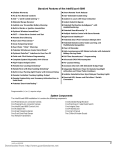Download Clifford GP500 Installation manual
Transcript
For the latest vehicle wiring information and for wiring diagrams and servicing information on older Clifford products 24-hour dealer website: www.clifforddealer.com USA Toll Free Technical Support: 800-444-4667 UK Technical Support Free Phone: 800-526708 Standard Features of GP500 Note: The system current draw of GP500 is 5mA plus or minus 0.5mA. Voltage operating range is 9V to 16V. ❑ Lifetime Warranty ❑ EC 97/24 Approved ❑ Weather Resistant ❑ Two ACG™ 2 Remote Controls ❑ Extended Range ❑ Built-In Two-Point Immobilizer™ ❑ Helmet Theft Protection System ❑ Fully Adjustable Dual-Level Piezo Sensor™ ❑ Digital Dual-Zone Tilt/Motion Sensor ❑ Self-Powered Siren with Key Override ❑ Built-In Indicator Light Flasher with On-Board Relay ❑ User-Selectable AutoArming™ ❑ Advanced CMOS Microcomputer Installation Manual/499 1 Standard Features of GP500 (Cont’d) ❑ BikeBeacon™ Vehicle Locator System ❑ FACT—False Alarm Control and Test ❑ Patented SmartPowerUp™ 2 ❑ Patented Smart AutoTesting™ ❑ Five-Event TotalRecall™ ❑ Remote Panic ❑ Patented Smart Prior Security Breach Alert ❑ Multiple-Vehicle Control ❑ Patented Remote Control Code Learning ❑ High-Luminescence LED with Automatic Battery-Saving Mode ❑ All Black Wiring 2 GP500 System Connections Control Unit The GP500 control unit must be installed as far away as possible from the engine. Under no circumstances should the unit be installed close to hot or moving parts. 1. Remove the seat and any side panels necessary to expose the battery terminals, indicator light wiring and ignition wires. 2. Select a location under the seat to mount the GP500 control unit. The control unit must be mounted in a flat and level position with the side bearing the Clifford logo facing upward. This location must stay dry and allow the use of screws or tie wraps to securely fasten the control unit to metal. Avoid hot or moving parts. 3. Mount the GP500 control unit using screws or tie wraps, but do not permanently affix it until all wiring and testing is complete. Installation Manual/499 3 LED Status Indicator Select a prominent location on the motorcycle that is highly visible from all directions. Discuss placement with the owner. 1. Verify there is adequate space to accommodate the LED, then drill a 4mm (#21 drill bit) hole and route the wires through it. 2. Mate the BLACK wire connector labeled LED (+) to the LED’s VIOLET wire as shown in the diagram on page 5. 3. Mate the BLACK wire labeled LED (-) to the LED’s BLACK wire as shown in the diagram on page 5. 4. Press the LED into place. PlainView 2 Coded Programming Switch 1. Discuss placement of the switch with the vehicle owner and avoid placing the switch where it can be pressed accidentally. 2. Mount the switch on to a clean, dry surface using the supplied adhesive tape. 3. Mate the switch’s locking connectors to the locking connector from the control unit. 4 GP500 Installation Manual/499 5 Indicator Lights 1. Connect a voltmeter lead to ground. 2. Access the indicator light harness near the indicator light switch, and turn on the left indicator light. 3. Probe the wires. When you probe the correct left indicator light wire, the voltmeter will read +12V when the indicator lights illuminate, and 0 volts when they turn off. 4. Turn on the right indicator light and repeat step 3. 5. Connect one of the two BLACK wires labeled Indicator Light +12V to the left indicator light circuit and the other wire labeled Indicator Light +12V to the right circuit as shown in the illustration on page 5. Starter and Ignition Immobilization Circuits 1. Locate the ignition switch wireloom under the gauges or key/ignition switch and use a voltmeter to locate the one wire that carries +12V throughout BOTH the cranking AND engine running cycles, and 0 volts when the ignition is off. 2. Start the engine, then cut the ignition wire. The engine should stop running. 3. As shown on page 5, connect the BLACK wire with the Ignition Input +12 Volts label to the key side of the cut ignition line. 6 GP500 4. Connect the BLACK wire with the Ignition Output +12 Volts label to the coil side of the cut ignition line. 5. Use a voltmeter to locate the one wire that carries +12V during the cranking cycle ONLY. Cut this wire, then try to start the engine. It should not crank. 6. Connect the BLACK wire with the Starter Input +12 Volts label to the key side of the cut starter line. 7. Connect the BLACK wire with the Starter Output +12 Volts label to the starter side of the cut starter line. NOTE: The starter cir cuit may carry a very high current. Be certain that the starter wire connections are solid. Each immobilization circuit can carry 15 amps. 8. Remove the labels from each of the wires. Self-Powered Siren with External Key Override If a thief disconnects power and/or cuts any or all of the wires while the system is armed, the siren will sound for five minutes and then reset. If power must be disconnected for servicing, an override key is provided to turn the siren off. Unlike other back-up battery sirens Installation Manual/499 7 that constantly drain the vehicle battery, Clifford’s design draws charging current only when the ignition is on (i.e., engine running). NOTE: The motorcycle must be ridden for eight hours af ter the si ren has been in stalled in or der to sufficiently charge the siren’s back-up battery. 1. Select a location for the siren under the seat or behind a side cover. Keep the siren away from direct exposure to rain and moisture. Avoid hot or moving parts. Also make sure there is sufficient clearance for the mounting screws behind the mounting surface. 2. You must firmly secure the siren using all three sheet metal screws supplied. Mount the siren away from areas of water ingress or excessive heat. Point the siren down to avoid moisture. 3. Connect the siren’s BROWN wire to the BLACK wire labeled Siren Output (-). 4. Connect the siren’s BLUE wire to the BLACK wire labeled Ignition Output +12V. 5. Connect the RED wire to the 5 amp fuse connected to the battery positive cable clamp. 6. Connect the BLACK wire to ground. 8 GP500 Final Wiring Connections 1. Connect the BLACK wire labeled Constant +12V 5A to the 5-amp fuseholder as shown on page 5. 2. Connect the BLACK wire labeled Constant +12V 10A to the 10-amp fuseholder as shown on page 5. 3. Attach the two fuseholders to the constant +12V source at the fuse panel, battery or ignition harness. 4. Use ring connectors to attach the two different BLACK wireloom wires (labeled ground) to two different chassis ground points or one of them directly to the vehicle fuse panel ground. The ground points must be very clean. A factory bolt that has been completely cleaned with a wire brush is recommended. NOTE: Power and test accessories after the basic sys tem has been tested. In di vidu ally fuse all accessory power connections. Individually fuse all +12V fuse panel connections. Installation Manual/499 9 SmartPowerUp™ 2 SmartPowerUp 2 ensures that the system powers up in the same state (disarmed, armed or valet mode) it was last in. When you first power up the system, it will silently enter its disarmed state. Remote Control Operation To transmit either channel 1, 2, or 3: Just press either button I, II, III, respectively. For instance, to transmit channel 3, press button III. Refer to the GP500 Owner’s Manual for more information on how to use the remote controls. Remote Control Channel Assignments Function Press button(s) Arm or disarm I Silently arm or disarm II 10 GP500 Function Press button(s) Instant AutoArming Bypass (press and hold button for three seconds while system is disarmed) III Dual-Level Piezo Sensor Warning Level Bypass (press button after arming the system). System provides four flashes. III Dual-Level Piezo Sensor Total Bypass (press and hold button for three seconds after arming the system). 7 flashes are provided. III Unassigned - This button can be assigned to control ACG-2 systems and accessories on other Clifford-equipped vehicles. I + II Unassigned - This button can be assigned to control ACG-2 systems and accessories on other Clifford-equipped vehicles. I + III Digital Tilt/Motion Sensor Warning Zone Bypass (press buttons after system is armed). 4 flashes are provided. II + III Digital Tilt/Motion Sensor Total Bypass (press and hold buttons for three seconds after system is armed). 7 flashes are provided. II + III Installation Manual/499 11 Function Press button(s) Dual-Level Piezo Sensor Adjustment (press and hold buttons for three seconds while system is disarmed and ignition is OFF). See Owners Manual for complete instructions. II + III FACT—False Alarm Control and Test The system microprocessor automatically checks for another activated sensor or trigger before sounding the siren a second time, thus preventing any further false alarms. If you wish to test FACT, simply, 1. Arm the system with the remote control. 2. Wait 15 seconds for the Piezo sensor to become active, then trigger the Dual-Level Piezo Sensor to activate the siren. 3. Do not disarm the system, let the siren complete its cycle. 4. Trigger the sensor again. The alarm should be silent. 5. Trigger the Digital Tilt/Motion Sensor (note that the alarm should be in an armed state for at least one minute prior to testing this sensor). The alarm should sound immediately. You may now disarm. 12 GP500 Five-Event TotalRecall The system’s nonvolatile memory records the identity of the last five activated or malfunctioning triggers and sensors: 1. With the ignition off, press and hold the unmarked side of the PlainView 2 switch. 2. Press remote control button 1 to arm the system, and then again to disarm. 3. The LED will blink 1–5 times, pause, then blink 1–5 times, etc. Write down the number of blinks in each cycle. 4. Refer to the chart below. The first number you wrote down was the most recently activated trigger or sensor. The next number is the second most recent, and so on up to as many as the last eight activations. LED flashes 1 flash Meaning Ignition switch was turned on while the system was armed 2 flashes Activation of Digital Tilt/Motion Sensor 3 flashes Activation of Dual-Level Piezo Sensor Installation Manual/499 13 LED flashes Meaning 4 flashes Activation of Helmet Theft Protection System 5 flashes Normally Open Auxiliary Input (Optional Accessory such as a seat trigger or pin switch). 5. If a sensor is often activated, decrease that sensor’s sensitivity (or reposition the control unit, if necessary). If a certain trigger is often activated, check the trigger wire for possible shorting. Programmable Features 1. Refer to the Table of Programmable features below and find the feature you wish to program. Make note of the number of times to press the ✱ button. 2. Turn the ignition on, or start the engine (skip this step if the engine is running). 3. Enter the factory preset valet code of “2” by pressing the marked side twice, then press the unmarked side once. Press and hold the ✱ button of the PlainView 2 switch for about 3 seconds until you hear a siren chirp. Release the button. You are now in Program mode. 14 GP500 4. Press and release the ✱ button of the PlainView 2 switch the number of times indicated for the feature you are programming. You will hear one chirp each time you press the ✱ button. Pause. You will hear a succession of chirps equal to the number of times you pressed the ✱ button. This audibly confirms your selection. 5. Perform the action, if any, in the “Secondary action” column. 6. Pause. You will hear either one or two chirps: Two chirps = ON, one chirp = OFF (If there is a NOTE for the selected feature, perform the actions noted). 7. You may now select another feature or exit program mode: a. To select a different feature column, go to step 4. b. To exit program mode, turn the ignition off (you’ll hear three chirps, the indicator lights flash three times, and the LED will turn off). The system will automatically exit program mode after 60 seconds. If you make an error, just turn off the ignition and start again. Installation Manual/499 15 Table of Programmable Features Feature AutoArming Factory Setting OFF No. of Secondtimes to ary Action press the ✱ button 2 - Program completion confirmation Result 1 chirp=OFF - 2 chirps=ON Chirps ON 3 - 1 chirp=OFF - 2 chirps=ON FACT ON 4 - 1 chirp=OFF - 2 chirps=ON Siren Duration 30 Seconds 5 - 1 chirp=30 - 2 chirps=60 3 chirps=90 16 GP500 Feature Factory Setting Triggers per Cycle 3 No. of Secondtimes to ary Action press the ✱ button 6 - Program completion confirmation 1 chirp=1 Result - 2 chirps=2 3 chirps=3 Change PIN code - 7 Wait for 3 chirps one chirp, then enter new PIN code. Wait. Enter new PIN code again. Auto Program New Remote - 9 Press button I Press button I again.The system provides 2 chirps. Installation Manual/499 1 chirp 17 Feature Factory Setting Program ACG-2 Remote Arm/Disarm - 10 Press button to be programmed 1 chirp Press the button to be programm ed again. System provides 2 chirps. Program ACG-2 Remote - - 11 Wait for one chirp, then press button to be programmed 2 chirps - Silent Arm 18 No. of Secondtimes to ary Action press the ✱ button Program completion confirmation Result GP500 Feature Factory Setting Program ACG-2 Remote Instant AutoArming Bypass - 12 Clear All Remotes - 15 Off 20 Passive Immobilization No. of Secondtimes to ary Action press the ✱ button Wait for one chirp, then press button to be programmed Program completion confirmation Result 3 chirps -. - 3 chirps - - 1 chirp - OFF - 2 chirps - ON System Checklist & Troubleshooting The following checklist and troubleshooting tips will assure that you have installed the system correctly. If the system does not react as Installation Manual/499 19 noted, follow the troubleshooting tip(s) denoted with a black box below that item, then repeat the step. Each successive step requires that the previous step has been completed as indicated. 1. Arm the system. The following should occur: ■ The siren chirps twice. This is the correct response. Proceed to the next step. ■ The siren chirps four times either immediately or 5-10 seconds after the initial two chirps. A trigger or sensor is active. Disarm with the remote control and turn the ignition ON. The LED will blink 1–5 times, pause, then repeat the same number of blinks (the blink cycle repeats five times). Refer to the following chart. If the Piezo Sensor is indicated, check the mounting location of the control unit and the sensitivity setting. LED flashes 1 flash 2 flashes 20 Meaning Ignition switch was turned on while the system was armed Activation of Digital Tilt/Motion Sensor GP500 LED flashes Meaning 3 flashes Activation of Dual-Level Piezo Sensor 4 flashes Activation of Helmet Theft Protection System 5 flashes Optional Accessory (such as a seat trigger or additional pin switch, etc.) p No chirps. Verify that the Chirps feature (column 2, row 1) is “On”, verify that the siren key turned to the “On” position, and check wiring connections as noted in the Self-Powered Siren section on page 7. ■ When you arm, the indicator lights will blink twice. p If the indicator lights blink only once, the system had previously AutoArmed itself passively and by pressing button 1 the system disarmed (remote disarming is acknowledged with one indicator light blink). Repeat step 1. p If only the right or the left side indicator lights blink, see the Indicator Lights section on page 6. p If no blinks, verify the indicator light bulbs are operational. If not, they must be replaced. If so, repeat steps 1-5 of the Indicator Lights section on page 6. Installation Manual/499 21 ■ When you arm, the LED will blink repeatedly. p If the LED does not blink, verify that the LED’s wires are solidly connected to the system’s wireloom. Warning: This is a 2-volt LED, testing with 12 volts will destroy the LED. ■ When you arm, the dual onboard Immobilization circuits will immediately engage (test this by turning the key in the ignition switch; the engine should neither start nor crank). p If the engine can be started or cranked, the starter and/or ignition immobilization circuits are miswired. Carefully retest the vehicle wires as noted on page 6. NOTE: If none of the above occurs when you arm the system, then perform the following diagnostics: p Check the power and ground connections. p Make sure the fuses are in the fuseholders. p Verify that the control unit connectors are properly inserted into the control unit. p Verify that the ignition input and output wires are connected to a true ignition line. Find the true ignition line by following steps 1-4 of the Starter and Ignition Immobilization Circuits section on page 6. 22 GP500 p Verify that the transmitters are programmed correctly. ■ NOTE: If the 10-amp fuse blows upon arming: p Disconnect the system’s two indicator light wires, replace the 10-amp fuse and re-arm. If the fuse does not blow, one (or both) of the vehicle’s indicator light wires is shorting. Find and correct the short(s), reconnect the indicator light wires, then rearm. 3. Disarm by pressing remote control button 1. The following should occur: ■ The siren chirps once. ■ The indicator lights blink once. ■ The LED turns off. ■ The Immobilization circuits immediately disengage (test this by turning the key in the ignition switch; the engine should crank, start and idle normally). 4. Test remote control range by standing approximately 20 feet from the motorcycle and use the remote control to arm and disarm the system. ■ The system will respond with the previously noted indications for arming and disarming. If not: Installation Manual/499 23 p Reposition the control unit as far as possible from heavy wirelooms and metal. p Verify that the remote control battery measures at least 3 volts while transmitting. p Verify the voltage at the control unit between the 5-amp fused power line and each of the two ground lines measures at least 12.0 volts (if less, make sure both chassis grounds are solid; if the grounds are solid, the vehicle battery may need charging, servicing or replacement). 24 GP500 Installation Manual/499 25 USA Headquarters: Clifford Electronics, Inc. 20750 Lassen Street, Chatsworth, CA 91311 Within USA: 1-800-824-3208 Phone: (818) 709-7551 Fax: (818)407-1743 All Clifford systems are covered by one or more of the following Clifford Electronics USA patents: 4,158,874; 4,233,642; 4,327,444; 4,383,242; 4,430,685; 4,845,464; 4,887,064; 4,890,108; 4,922,224; 4,997,053; 5,081,667; 5,146,215; 5,157,375; 5,467,070; 5,650,744 and other patents pending. © Copyright Clifford Electronics, Inc., 1999 26 32-840B/USGPIM/399 GP500





































